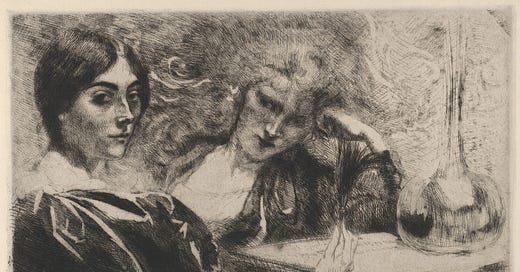In Donna Tartt’s The Goldfinch, there is a scene where the young protagonist Theo visits one of the other victims of the bombing that killed his mother, a girl his age called Pippa, as she recovers from a cracked skull in bed. At some point during their conversation, she reaches for a peculiar-looking lollipop on her nightstand and when she kisses him later, he tastes the lollipop on her lips.
Sitting there on the edge of her bed, it felt like the waking-up moment between dream and daylight where everything merged and mingled just as it was about to change, all in the same, fluid, euphoric slide: rainy light, Pippa sitting up with Hobie in the doorway, and her kiss (with the peculiar flavor of what I now believe to have been a morphine lollipop) still sticky on my lips. Yet I’m not sure that even morphine would account for how lightheaded I felt at that moment, how smilingly wrapped up in happiness and beauty.
The Goldfinch is one of my favourite books, Tartt has such a way of painting a scene and establishing mood. I’ve always thought of this scene as particularly striking, partly because I didn’t know morphine lollipops existed until I read it for the first time, partly because of the juxtaposition of powerful painkiller and teenage girl recovering in bed, chatting innocently about music, being sleepy all the time, and dead mothers.
Later in the book, it’s also mentioned that morphine lollipops were given to soldiers wounded in action. According to this article, fentanyl lollipops are handed out to wounded soldiers in Afghanistan because absorption is quicker through blood vessels in the mouth and the lollipop makes it easier to control dosage. Fentanyl is about a hundred times more powerful than morphine so perhaps we should be glad that Pippa was given the latter. We can also imagine that her lollipop didn’t taste particularly good—the soldiers at least get berry flavour.
Both morphine and fentanyl are opioids. Opium, used in both medicine and the illegal drug trade, is considered a controlled substance and illegal to grow throughout most of the developed world. There’s a certain fascination with drugs among writers and artists, a hope or expectation that they will inspire us to create masterpieces, open our consciousness to greatness we wouldn’t have access to otherwise. Their lures and devastating side effects have been immortalised in art many times over—consider Thomas De Quincey’s Confessions of an English Opium Eater or Charles Baudelaire’s long-term use of laudanum, tincture of opium. Morphine and other opium products were particularly notorious in fin-de-siècle France.
Their illegal nature is part of their allure. What we tend to forget is that in some respects, widely consumed legal drugs might be as or even more dangerous than their illegal counterparts. Tobacco, for example, is at least as addicting as heroin (coincidentally also produced from opium).1
Alcohol has arguably wrought more damage over the centuries than many other drugs. Terence McKenna describes alcoholism as a “condition of ego obsession and inability to resist the drive toward immediate gratification”, which makes it more dangerous than weed or magic mushrooms. Frequent alcohol consumption has devastating effects on intelligence and emotional control. It also gave rise to or at least helped along the suppression of women and sexual stereotypes, in the form of phenomena such as drunk men beating their wives. Alcohol misuse by Native Americans is so widespread that it has become its own stereotype.
And yet it’s the illegal that we’re drawn to, whether in the form of painkiller abuse or the more harmless marihuana that is slowly being legalized in some regions. What can we learn from this?
First, that we should be aware of the effects of all substances we choose to put into our bodies instead of blindly accepting what has been decreed. Rules and regulations, after all, might stem not only from health concerns but also from historical and sociopolitical factors.
And second, that it’s the prerogative of art to paint the forbidden or toxic in an alluring light—to find or create beauty in everything. The romance of the morphine lollipop might be entertaining in a work of fiction but it’s always worth highlighting that words on a page or brushstrokes on a canvas can only ever create a highly simplified image of the reality we live in.
Author Notes
This is what I wrote when I had neither the energy nor the will to write anything else (shareable): a string of free association around this literary image that for some reason I keep coming back to. Sometimes I think all of art is just associations the artist got obsessed with and apparently Leanne agrees with me at least on the obsession part. If these associations are unusual or packaged well enough, the piece is successful. Easier said than done, right?
Next weekend I’ll visit Tokyo Game Show, hang out with friends. I don’t know much writing will happen around that. Possibly I just need a bit of a break, reading and playing games, doing other things.
Food of the Gods by Terence McKenna is one fascinating perspective on both legal and illegal drugs and drug use throughout the ages.




Really enjoyed this, Vanessa. Great read. I did know about morphine lollipops, though I don't remember from what reference. I haven't read The Goldfinch, but that's a wonderful passage you quoted.
Enjoy TGS! I'm envious. Would love to be there. Would absolutely love a post about what you get to see/play etc, along with pics! :)